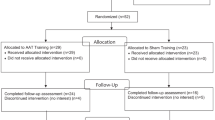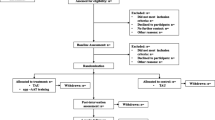Abstract
Rationale
Drug-addicted individuals show automatic approach tendencies towards drug-related cues, i.e., an approach bias (ApB). Nevertheless, little is known about ApB in tobacco smokers and about the presence of ApB after smoking abstinence.
Objectives
We investigated ApB to smoking cues in heavy tobacco smokers versus never-smokers and studied its relation to smoking characteristics and craving. Second, we compared ApBs of heavy smokers with biases of abstinent heavy smokers.
Method
A group of current heavy smokers (n = 24), ex-smokers who were abstinent for at least 5 years (n = 20), and never-smokers (n = 20) took part in the experiment. An indirect smoking approach avoidance task was performed, in which participants were required to respond to pictures of smoking and neutral cues by pulling (approach) or pushing (avoid) on a joystick, according to the content-irrelevant format of the picture (landscape or portrait). Craving scores were examined using the Questionnaire of Smoking Urges.
Results
Heavy smokers showed an ApB for smoking cues compared to ex-smokers and never-smokers, which correlated positively to craving scores. There were no group differences in ApB scores for ex-smokers and never-smokers.
Conclusion
These results suggest that ApBs for smoking cues are present in heavy smokers and decrease after long-term successful smoking cessation.


Similar content being viewed by others
Notes
Excluding these two ex-smokers from the analyses still results in a significant interaction effect of image type × group (F(1, 59) = 5.10, p = 0.009, η 2 = 0.147) on the 2 (image type) × 3 (group) mixed ANOVA.
Abbreviations
- ApB:
-
Approach bias
- AAT:
-
Approach avoidance task
- QSU:
-
Questionnaire of smoking urges
References
Attwood AS, O’Sullivan H, Leonards U, Mackintosh B, Munafo MR (2008) Attentional bias training and cue reactivity in cigarette smokers. Addiction 103:1875–1882
Baler RD, Volkow ND (2006) Drug addiction: the neurobiology of disrupted self-control. Trends Mol Med 12:559–566
Bechara A (2005) Decision making, impulse control and loss of willpower to resist drugs: a neurocognitive perspective. Nat Neurosci 8:1458–1463
Beck AT, Steer RA, Ball R, Ranieri W (1996) Comparison of Beck Depression Inventories -IA and -II in psychiatric outpatients. J Pers Assess 67:588–597
Bradley B, Field M, Mogg K, De Houwer J (2004) Attentional and evaluative biases for smoking cues in nicotine dependence: component processes of biases in visual orienting. Behav Pharmacol 15:29–36
Bradley BP, Field M, Healy H, Mogg K (2008) Do the affective properties of smoking-related cues influence attentional and approach biases in cigarette smokers? J Psychopharmacol 22:737–745
Brainard DH (1997) The psychophysics toolbox. Spat Vis 10:433–436
Chanon VW, Sours CR, Boettiger CA (2010) Attentional bias toward cigarette cues in active smokers. Psychopharmacology 212:309–320
Cousijn J, Goudriaan AE, Wiers RW (2011) Reaching out towards cannabis: approach-bias in heavy cannabis users predicts changes in cannabis use. Addiction 106:1667–1674
Cox LS, Tiffany ST, Christen AG (2001) Evaluation of the brief questionnaire of smoking urges (QSU-brief) in laboratory and clinical settings. Nicotine Tob Res 3:7–16
Dawe S, Gullo MJ, Loxton NJ (2004) Reward drive and rash impulsiveness as dimensions of impulsivity: implications for substance misuse. Addict Behav 29:1389–1405
De Houwer J (2003) A structural analysis of indirect measures of attitudes. In: Musch J, Klauer KC (eds) The psychology of evaluation: Affective processes in cognition and emotion. Lawrence Erlbaum, Mahwah, pp 219–244
De Houwer J (2006) What are implicit measures and why are we using them. In: Wiers RW, Stacy AW (eds) The handbook of implicit cognition and addiction. Sage, Thousand Oaks, pp 11–28
Drobes DJ, Elibero A, Evans DE (2006) Attentional bias for smoking and affective stimuli: a Stroop task study. Psychol Addict Behav J Soc Psychol Addict Behav 20:490–495
Eberl C, Wiers RW, Pawelczack S, Rinck M, Becker ES, Lindenmeyer J (2013) Approach bias modification in alcohol dependence: do clinical effects replicate and for whom does it work best? Dev Cogn Neurosci 4:38–51
Ernst LH, Plichta MM, Dresler T, Zesewitz AK, Tupak SV, Haeussinger FB, Fischer M, Polak T, Fallgatter AJ, Ehlis AC (2012) Prefrontal correlates of approach preferences for alcohol stimuli in alcohol dependence. Addict Biol. doi:10.1111/adb.12005
Everitt BJ, Belin D, Economidou D, Pelloux Y, Dalley JW, Robbins TW (2008) Review. Neural mechanisms underlying the vulnerability to develop compulsive drug-seeking habits and addiction. Philosophical Transactions of the Royal Society of London Series B. Biol Sci 363:3125–3135
Ferguson SG, Shiffman S (2009) The relevance and treatment of cue-induced cravings in tobacco dependence. J Subst Abus Treat 36:235–243
Heatherton TF, Kozlowski LT, Frecker RC, Fagerstrom KO (1991) The Fagerstrom test for nicotine dependence: a revision of the Fagerstrom Tolerance Questionnaire. Br J Addict 86:1119–1127
Hogarth LC, Mogg K, Bradley BP, Duka T, Dickinson A (2003) Attentional orienting towards smoking-related stimuli. Behav Pharmacol 14:153–160
Hughes JR, Peters EN, Naud S (2008) Relapse to smoking after 1 year of abstinence: a meta-analysis. Addict Behav 33:1516–1520
Huijding J, de Jong PJ (2006) Specific predictive power of automatic spider-related affective associations for controllable and uncontrollable fear responses toward spiders. Behav Res Ther 44:161–176
Janes AC, Pizzagalli DA, Richardt S, deB Frederick B, Chuzi S, Pachas G, Culhane MA, Holmes AJ, Fava M, Evins AE, Kaufman MJ (2010) Brain reactivity to smoking cues prior to smoking cessation predicts ability to maintain tobacco abstinence. Biol Psychiatry 67:722–729
Kamboj SK, Joye A, Das RK, Gibson AJ, Morgan CJ, Curran HV (2012) Cue exposure and response prevention with heavy smokers: a laboratory-based randomised placebo-controlled trial examining the effects of D-cycloserine on cue reactivity and attentional bias. Psychopharmacology 221:273–284
Krieglmeyer R, Deutsch R (2010) Comparing measures of approach-avoidance behaviour: the manikin task vs. two versions of the joystick task. Cogn Emot 24:810–828
Littel M, Franken IH (2011) Intentional modulation of the late positive potential in response to smoking cues by cognitive strategies in smokers. PLoS One 6:e27519
Lussier JP, Higgins ST, Badger GJ (2005) Influence of the duration of abstinence on the relative reinforcing effects of cigarette smoking. Psychopharmacology 181:486–495
Mead AN, Stephens DN (1998) AMPA-receptors are involved in the expression of amphetamine-induced behavioural sensitisation, but not in the expression of amphetamine-induced conditioned activity in mice. Neuropharmacology 37:1131–1138
Mogg K, Bradley BP, Field M, De Houwer J (2003) Eye movements to smoking-related pictures in smokers: relationship between attentional biases and implicit and explicit measures of stimulus valence. Addiction 98:825–836
Mogg K, Field M, Bradley BP (2005) Attentional and approach biases for smoking cues in smokers: an investigation of competing theoretical views of addiction. Psychopharmacology 180:333–341
Munafo MR, Johnstone EC (2008) Smoking status moderates the association of the dopamine D4 receptor (DRD4) gene VNTR polymorphism with selective processing of smoking-related cues. Addict Biol 13:435–439
Munafo M, Mogg K, Roberts S, Bradley BP, Murphy M (2003) Selective processing of smoking-related cues in current smokers, ex-smokers and never-smokers on the modified Stroop task. J Psychopharmacol 17:310–316
Munafo MR, Johnstone EC, Mackintosh B (2005) Association of serotonin transporter genotype with selective processing of smoking-related stimuli in current smokers and ex-smokers. Nicotine Tob Res 7:773–778
Nestor L, McCabe E, Jones J, Clancy L, Garavan H (2011) Differences in “bottom-up” and “top-down” neural activity in current and former cigarette smokers: evidence for neural substrates which may promote nicotine abstinence through increased cognitive control. Neuroimage 56:2258–2275
Oldfield RC (1971) The assessment and analysis of handedness: the Edinburgh inventory. Neuropsychologia 9:97–113
Patton JH, Stanford MS, Barratt ES (1995) Factor structure of the Barratt impulsiveness scale. J Clin Psychol 51:768–774
Rinck M, Becker ES (2007) Approach and avoidance in fear of spiders. J Behav Ther Exp Psychiatry 38:105–120
Robbins TW, Everitt BJ (1999) Drug addiction: bad habits add up. Nature 398:567–570
Robinson TE, Berridge KC (1993) The neural basis of drug craving: an incentive-sensitization theory of addiction. Brain Res Brain Res Rev 18:247–291
Robinson TE, Berridge KC (2003) Addiction. Annu Rev Psychol 54:25–53
Saunders JB, Aasland OG, Babor TF, de la Fuente JR, Grant M (1993) Development of the Alcohol Use Disorders Identification Test (AUDIT): WHO Collaborative Project on Early Detection of Persons with Harmful Alcohol Consumption–II. Addiction 88:791–804
Sheehan DV, Lecrubier Y, Sheehan KH, Amorim P, Janavs J, Weiller E, Hergueta T, Baker R, Dunbar GC (1998) The Mini-International Neuropsychiatric Interview (M.I.N.I.): the development and validation of a structured diagnostic psychiatric interview for DSM-IV and ICD-10. J Clin Psychiatry 59(Suppl 20):22–33, quiz 34–57
Stacy AW, Wiers RW (2010) Implicit cognition and addiction: a tool for explaining paradoxical behavior. Annu Rev Clin Psychol 6:551–575
Thewissen R, Havermans RC, Geschwind N, van den Hout M, Jansen A (2007) Pavlovian conditioning of an approach bias in low-dependent smokers. Psychopharmacology 194:33–39
Tiffany ST (1990) A cognitive model of drug urges and drug-use behavior: role of automatic and nonautomatic processes. Psychol Rev 97:147–168
Velicer WF, DiClemente CC, Prochaska JO, Brandenburg N (1985) Decisional balance measure for assessing and predicting smoking status. J Pers Soc Psychol 48:1279–1289
Verdejo-Garcia A, Perez-Garcia M (2007) Ecological assessment of executive functions in substance dependent individuals. Drug Alcohol Depend 90:48–55
Wagner DD, Dal Cin S, Sargent JD, Kelley WM, Heatherton TF (2011) Spontaneous action representation in smokers when watching movie characters smoke. J Neurosci Off J Soc Neurosci 31:894–898
Waters AJ, Feyerabend C (2000) Determinants and effects of attentional bias in smokers. Psychol Addict Behav J Soc Psychol Addict Behav 14:111–120
Waters AJ, Shiffman S, Bradley BP, Mogg K (2003a) Attentional shifts to smoking cues in smokers. Addiction 98:1409–1417
Waters AJ, Shiffman S, Sayette MA, Paty JA, Gwaltney CJ, Balabanis MH (2003b) Attentional bias predicts outcome in smoking cessation. Health Psychol 22:378–387
Watson P, de Wit S, Hommel B, Wiers RW (2012) Motivational mechanisms and outcome expectancies underlying the approach bias toward addictive substances. Front Psychol 3:440
Watson P, de Wit S, Cousijn J, Hommel B, Wiers RW (2013) Motivational mechanisms underlying the approach bias to cigarettes. Experimental Psychopathology (in press)
Wiers RW, Bartholow BD, van den Wildenberg E, Thush C, Engels RC, Sher KJ, Grenard J, Ames SL, Stacy AW (2007) Automatic and controlled processes and the development of addictive behaviors in adolescents: a review and a model. Pharmacol Biochem Behav 86:263–283
Wiers RW, Rinck M, Dictus M, van den Wildenberg E (2009) Relatively strong automatic appetitive action-tendencies in male carriers of the OPRM1 G-allele. Genes Brain Behav 8:101–106
Wiers RW, Rinck M, Kordts R, Houben K, Strack F (2010) Retraining automatic action-tendencies to approach alcohol in hazardous drinkers. Addiction 105:279–287
Wiers RW, Eberl C, Rinck M, Becker ES, Lindenmeyer J (2011) Retraining automatic action tendencies changes alcoholic patients’ approach bias for alcohol and improves treatment outcome. Psychol Sci 22:490–497
Wiers RW, Gladwin TE, Hofmann W, Salemink E, Ridderinkhof KR (2013) Cognitive bias modification and cognitive control training in addiction and related psychopathology: mechanisms, clinical perspectives, and ways forward. Clin Psychol Sci 1:192–212
Willenbockel V, Sadr J, Fiset D, Horne GO, Gosselin F, Tanaka JW (2010) Controlling low-level image properties: the SHINE toolbox. Behav Res Methods 42:671–684
Yoon JH, Higgins ST, Bradstreet MP, Badger GJ, Thomas CS (2009) Changes in the relative reinforcing effects of cigarette smoking as a function of initial abstinence. Psychopharmacology 205:305–318
Zhou Y, Li X, Zhang M, Zhang F, Zhu C, Shen M (2012) Behavioural approach tendencies to heroin-related stimuli in abstinent heroin abusers. Psychopharmacology 221:171–176
Acknowledgments
The study was supported by a grant from the German Federal Ministry of Education and Research: NGFN: 01GS08159 (Gallinat). The authors thank Georgina Torbet, Noah Gabriel Martin, and James Harwood for proofreading.
Conflict of interest
None
Author information
Authors and Affiliations
Corresponding author
Rights and permissions
About this article
Cite this article
Wiers, C.E., Kühn, S., Javadi, A.H. et al. Automatic approach bias towards smoking cues is present in smokers but not in ex-smokers. Psychopharmacology 229, 187–197 (2013). https://doi.org/10.1007/s00213-013-3098-5
Received:
Accepted:
Published:
Issue Date:
DOI: https://doi.org/10.1007/s00213-013-3098-5




